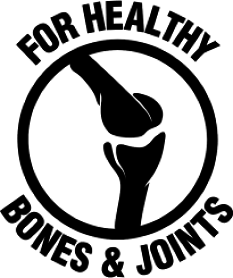Bone and Joint Health
OCTOBER BLOG
BONE AND JOINT HEALTH
What if one of the best things for your bones, which had an ingredient proven to increase bone density in the neck, back and legs of more than 3,198 women, was actually banned in the 1920’s! Research from The National Institute of Health, shows that an ingredient in beer builds bone and collagen in women. The ingredient is orthosilicic acid, which comes from the hops in beer. Studies show orthosilicic acid causes the body to make osteoblasts, the bone building cells. Scientists have discovered how to extract orthosilicic acid and other nutrients from hops.
You and Your Joints
A joint is the connection between two bones. Joints and their surrounding structures allow movement such as bending, wiggling your hips and turning of the head. Smooth tissue, cartilage and synovium plus a lubricant - synovial fluid, cushion the joints so bones do not rub together. The best way to care for your joints is to keep them and your muscles, ligaments, and bones strong and stable. Here are some tips for good joint health.
Question is, if calcium works so well building strong bones, why do millions of American women suffer bone fractures each year? Why do women in the U.S. suffer from weaker bones than women in countries where women don't take calcium?
The secret why certain women have the strongest bones despite poverty
Women in sub-Saharan Africa don't have access to calcium supplements, nor do they go to the gym. They don't eat many dairy products, yet they have some of the strongest bones in the world. Research from Yale University indicates bone fractures are virtually unknown in sub-Saharan Africa.
So why do women in Africa have strong bones? Their secret is they spend a lot of time in the sun causing then to produce lots of vitamin D! Vitamin D helps build bone in these poverty stricken women.
What’s out there????
Does that mean you should spend hours in the sun? No. In fact, there's an easier way to keep your bones strong. One considered the most absorbable form of vitamin D is cholecalciferol.
Cholecalciferol is vitamin D3 which assists the body absorb calcium. Cholecalciferol is used as a dietary supplement in people who do not get enough vitamin D in their diets. According to new research, 700 IU of daily cholecalciferol reduced hip fractures in women by up to 60% and assisted the healing of wrist and spinal fractures in 3,270 women.
An often overlooked mineral is strontium. Most women have never heard of strontium. Strontium has been used for bone health for decades. If you've used Sensodyne toothpaste, you have used strontium! Strontium is the active ingredient in Sensodyne, helping people with sensitive teeth keep their teeth strong.
A special form of strontium, strontium ranelate, can increase bone formation and prevent bone loss when used in postmenopausal women with osteoporosis. It's not known if strontium contained in dietary supplements has these effects. There is interest in using strontium for osteoarthritis. Developing research suggests it might boost the formation of collagen and cartilage in joints.
Here’s a bone-building nutrient that gets little respect! 13 clinical studies found Vitamin K reduced vertebral fractures by 60%, hip fractures by 77% and all other fractures by 81%? Unless you eat platefuls of dark green vegetables, mustard greens, kale or spinach, you may not get enough Vitamin K for your bones. Vitamin K activates two proteins in the body:
- Osteocalcin - deposits calcium to your bones and
- Matrix-Gla - prevents calcium build up in the heart, arteries, breasts and kidneys.
Important supplements for maintaining strong bones.
- L-lysine - Collagen is like "glue" – it holds your bones together causing the bones to move in unison. To build collagen you need an amino acid,. Many women are deficient in L-lysine, which happens to be found in protein sources such as chicken gizzards, snail meat and shellfish.
L-lysine also helps your body absorb calcium and decreases the amount of calcium you lose in your urine. A study indicated 400 mg of L-lysine helped osteoporotic women absorb more calcium and excrete less in their urine. Researchers also found L-lysine may prevent osteoporosis.
- Manganese—Researchers discovered that manganese promotes bone growth by helping build cartilage and slowing bone loss. Also discovered, women with osteoporosis have lower levels of manganese.12 Manganese can be taken orally for the prevention and treatment of manganese deficiency, a condition in which the body doesn’t produce enough manganese. It is also used for osteoporosis - weak bones, , osteoarthritis - painful joints,“ anemia – “ tired blood,” weight loss and symptoms of PMS - premenstrual syndrome.
- Zinc—Studies have shown that zinc builds bone, increases mineral uptake and bone growth and may prevent bones from becoming brittle.15 Zinc is needed for proper growth and body maintenance. Zinc is found in several systems and biological reactions. Zinc is needed for immune function, wound healing, blood clotting, thyroid function and much more. High levels of zinc can be found in meats, seafood, dairy products, nuts, legumes and whole grains
- Calcium and Vitamin D. Calcium is a mineral that is an essential part of bones and teeth. The heart, nerves and blood-clotting systems also need calcium to work. The bones and teeth contain over 99% of the calcium in the human body. Calcium is also found in the blood, muscles, and other tissue. A recent study found that vitamin D may be the key to efficiently absorbing and using calcium, Journal of the American Medical Association, November 9, 2005.
- Glucosamine and Chondroitin. These two joint supplements are from substances naturally found in healthy cartilage. Research suggests that glucosamine sulfate – alone or in combination with chondroitin sulfate – appears to relieve pain, improve joint mobility, and slow osteoarthritis-related damage to the joints. If you weigh between 120 and 200 pounds, take 1,500 mg of glucosamine and 1,200 mg of chondroitin daily and expect to wait up to two months to see results. These joint supplements may interact with drugs like diuretics and blood thinners, so let your doctor know that you’re taking them.
- SAMe. This naturally occurring molecule, S-adenosy-L-methioine delivers sulfur to cartilage, which helps build strong joints. Research suggests that SAMe may be as effective as drugs like aspirin and ibuprofen at relieving joint pain and improving function, Journal of Family Practice, May 2002.
Natural anti-inflammatory compounds, may work as well as aspirin and ibuprofen for treating osteoarthritis.
- Turmeric - A little-known fact about Turmeric is that it can be used as a natural pain-reliever and reduce inflammation. Studies have shown that the anti-pain and anti-inflammatory effects of Turmeric are equal to that of Ibuprofen and even better, Turmeric is all-natural.
- Ginger - Most research shows taking ginger orally will slightly reduce pain in some sufferers of osteoarthritis. A small study shows that ginger might work as well as ibuprofen for pain in some people with hip and knee osteoarthritis.
- Ginger may thin the blood, so consult your doctor before taking it with other blood thinning drugs such as aspirin and Coumadin or with herbs such as ginkgo.
- Boswellia Serrata - is a tree native to India that produces special compounds found to have strong anti-inflammatory and anticancer, effects. Before inflammation-lowering medications and supplements existed, extracts derived from different species of the boswellia tree were used to treat inflammatory conditions, such as arthritis, inflammatory bowel disease and heart disease.
Healthy Aging: Preserving Your Bones and Joints
Bone and joint health begin in childhood, says Dr. Sundeep Khosla, director of the Aging Bone, Muscle and Joint Program within the Mayo Clinic's Kogod Center on Aging. As aging chips away at bone and joint health, experts explain what you can do to something.
Physical activity is important for loading the bones and helping them develop. When the skeleton is rapidly growing, an increased need for calcium may cause thinning. When kids fall, they get wrist fractures, a defect tied to low bone mass, Khosla says. Calcium, vitamin D, diet and exercise are the cornerstones of bone health.
In the late 20s, early 30s you achieve peak bone mass. School and career demands disrupt health and exercise regimens. Diet changes for young adults, limit caffeinated beverages and drink more water. Alcohol consumption can affect bone health. Limit meals on the go.
Maintain Bone Mass in Midlife
After 50, calcium requirements for post-menopausal women rise from 1,000 to 1,200 milligrams,but calorie requirements don't. As metabolism slows, weight creeps up. "With women, the menopausal transition is when the acceleration of bone loss occurs because of hormonal level fluctuations. Men also experience hormonal changes with testosterone and estrogen, but their bone loss is more gradual and less marked.
Here are some health conscious suggestions for bone and joint health.
- Watch Your Weight. Keeping weight within a healthy range is best for your joints. Weight-bearing joints, such as knees, hips and back, have to support some, if not all, of your body weight. Research has shown that with every pound gained, a person puts four times more stress on the knees.
- Exercise. Research suggests that aerobic exercise, activities that get the heart rate up, also helps reduce joint swelling. If joints bother you, opt for “non-pounding” exercises such as low-impact exercises, such as swimming or bicycling. Take frequent breaks at work. Stretch or go for a short walk. If you can't leave the office, try taking phone calls while standing. Less movement means more stiffness.
- Build Muscles to Support Joints with weight training. Strong muscles support joints. If there isn’t enough muscle, the joints take a pounding. This is especially noticeable in the spine, hips, and knees, areas which must also support the entire weight of the body!
- Help Joints with a Strong Core. Make sure your exercise routine includes activities that strengthen your core – this includes the chest, back and abdomen. Strong abdominal and back muscles help keep balance and prevent falls. Balance and core-strengthening exercises such as yoga and Tai Chi reduce the risk of falls and resulting fractures.
- Eating Right Nourishes Joints. A healthy diet is good for joints by building strong bones and muscles. For calcium - eating foods such as milk, yogurt, broccoli, kale, figs, and fortified foods like soy or almond milk. For muscles – protein! Exactly how much depends on your age, sex, and how active you are. Most get enough protein through lean meats, seafood, beans, legumes, soy products and nuts. You may also need vitamin D to keep your bones and joints in good health.
- Ditch the high heels. Unless you're a fashion model, you can live without high heels! Experts say a three-inch heel stresses your foot seven times more than a one-inch heel. Heels also put extra stress on your knees and back, plus increase your risk of developing osteoarthritis.
- Handle heavy loads. To make heavy loads easier to handle, use the larger, stronger joints and muscles to ease the stress of smaller joints and spread the load. When lifting or carrying an item, use the palms of both hands and hold items close to your body. For joint safety, slide objects whenever possible rather than lifting them.
- Throw some fish on the grill. Omega-3 fatty acids found in cold-water fish, such as salmon and mackerel, help keep joints healthy. Studies show omega-3s reduce pain and inflammation of stiff joints in people with arthritis. Or, consider supplementing your diet with fish oil capsules.
- Stttrrreeetttccchhh. Stretching isn't just for workouts. Breaks throughout the day,
including at work, help to get re-energized and keep muscles and ligaments flexible and strong.
ALWAYS CONSULT YOUR PERSONAL HEALTH CARE PROFESSIONAL
- https://www.advancedbionutritionals.com/Production/JV/PPC/Ultimate-Bone-Support-ABJZPPCBOF15.htm?utm_creative=b&msclkid=31a3fa5c6d2716b9b56ea1fd501dc49a&utm_source=bing&utm_medium=cpc&utm_campaign=%5BROI%5D%20Ultimate%20Bone%20Support&utm_term=%2Bbone%20%2Bhealing&utm_content=Bone%20Healing
- https://www.webmd.com/arthritis/caring-your-joints#1
- https://health.usnews.com/health-news/patient-advice/articles/2015/05/13/healthy-aging-preserving-your-bones-and-joints
- https://www.drweil.com/health-wellness/body-mind-spirit/bone-joint/supplements-for-bones-and-joints/
- https://www.arthritis.org/living-with-arthritis/pain-management/joint-protection/joint-health.php
- https://herbalistreport.com/joint_supplements_Bing/index.html
- https://www.webmd.com/vitamins/ai/ingredientmono-1077/strontium
- https://www.drugs.com/mtm/cholecalciferol.html
- https://www.webmd.com/vitamins/ai/ingredientmono-182/manganese
- https://www.webmd.com/vitamins/ai/ingredientmono-982/zinc
- https://www.webmd.com/vitamins/ai/ingredientmono-781/calcium
- https://draxe.com/boswellia/




